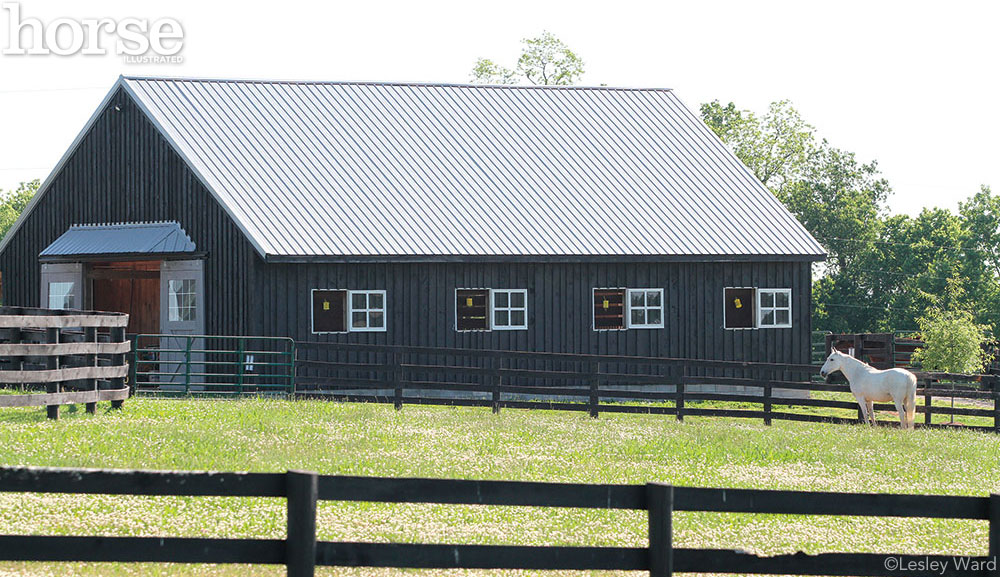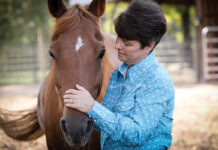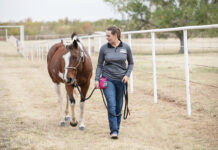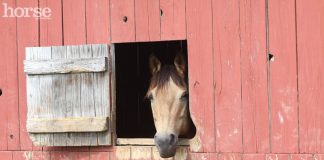Given the option, most horse owners would pasture their horses in spacious fields where the horses can run or graze to their heart’s content. Realistically, most of us simply can’t afford sizeable properties, and we feel fortunate to own what we do. In some areas of the country, real estate prices are so prohibitive that even the wealthy keep their horses in smaller quarters.

Buying Small Horse Property
If you’re in the market to buy horse property, you probably want to know the horse-per-acre ratio for pasture feeding. The answer to this depends on the quality of pasture, type of soil, variety of grasses, hours your horses are turned out, growing conditions, and how diligently the pasture is managed. A general rule of thumb is 1 acre per horse for good pasture, but as much as 2½ acres per horse for a poorly managed field. Unfortunately, smaller acreages tend to be overpopulated, overgrazed, and under-managed, so they fall in the latter category.
If you are thinking of buying vacant land to build on, do not simply rely on the estimate of 1 acre per horse. That’s like thinking your annual salary is the amount of money you can spend every year. You must factor in what’s taken out—your house, yard, and outbuildings eat into the total acreage for pasture. A 10-acre parcel may suddenly seem like a postage stamp if you don’t deduct occupied land. For instance, there may be a grove of trees you’d prefer to leave as-is for a windbreak, or topographical features may prevent pasture access at certain times of the year (such as low-lying areas that tend to flood). Or you may need to isolate a septic field.
Carefully assess your current acreage requirements, yet plan for the future. Horse owners are notorious accumulators—just look in your tack trunk, for example. You might start with two horses, but if you have an empty stall, watch out! If you don’t fill it yourself, your friends will do their best to give you a free or rescued horse.
Ask yourself: Will I eventually buy a tractor and need a storage shed? Is building an indoor or outdoor arena a possibility? What about adding on to an existing building? Will I need space around these structures for fire truck or large equipment access? If you answer “yes” or “maybe” to any of these questions, be sure to buy enough land from the outset to accomplish your goals.
Owners of small horse properties often start with preconceived notions of how they will care for their horses, yet modify many of those ideas from practical experience.
Three horse owners, whose farms are located on the East Coast, Midwest, and West Coast, describe their properties and share how they’ve learned to get more out of less.
Maine: Four Horses on 4 Acres
Dusty Perin is an award-winning freelance photographer and writer who has lived on a 4-acre farm in Acton, Maine, since 1988. She and her husband, Gary, own four Arabian horses who live leisurely lives as occasional models for Perin’s business.
“When we moved here, this property was not adequately set up for horses, so we put up three-board fence combined with electric and built all the outbuildings,” Perin says.
“Because we live on a main road, our paddocks are interconnected so we can move horses from one to the next without needing to take them outside the fence.”
For shelter, Perin’s horses share a large run-in divided into two stalls that are matted and bedded. Manure is moved with a compact tractor to the back of the property along a treeline where it composts, much to the delight of nearby gardeners.
“Accidentally, we discovered that if you bury bad or old hay in the pile, worms seem to work overtime, and the composting process speeds up significantly,” Perin says.
Because Perin feeds hay year-round, and a lack of storage space made numerous trips to her supplier a necessary evil, she recently built a 16-foot by 24-foot building that can accommodate 550 bales.
Perin notes that one of her toughest small-farm problems is related to weather, especially those notorious nor’easters.
“Once the ground around here gets saturated, there’s nowhere for the water to go, so the end result is a surplus of mud,” she says. “The horses’ hooves tear up the little space they have, and excess rainwater washes out parts of the driveway. Then, we have to spread crushed limestone to fill it in.” Little wonder that Perin says the tractor with its bucket attachment is her favorite farm tool.
Successfully keeping horses on a small property not only requires the right equipment, but also the ability to adapt to changing circumstances.
Wisconsin: Six Horses on 10 Acres
Elizabeth “Libby” Cameron is a renowned portrait artist who lives with an assortment of horses, dogs and cats on Faerietale Farm, a 10-acre horse property in Caledonia, Wisc. Because she built the house, barn and run-ins, she was able to design the property to her own specifications, yet 11 years of real-life horsekeeping on small acreage has caused her to scrap some original ideas and make better use of her space.
“I thought I had to have a wash rack in my new barn, but I never used it enough to justify the wasted space, so I eventually built another box stall and tool storage aisle in that area,” Cameron says.
“I also thought that I wanted a paved circular driveway in front of the barn, until I realized that the width of that area was just right for pre-ride warmups and longeing,” Cameron continues. “I scraped away the base gravel and voila!, I had a warmup ring and a driveway.
“Then, I built an outdoor arena directly behind the house only to realize that if I had an accident while riding alone no one would see me, so I converted that area into a paddock and now ride in a small pasture visible from the road,” she says.
“When I first moved here, I thought I’d have two horses and put them in stalls every night,” Cameron continues. “Now that I am caring for six horses, I’ve simplified my daily routine with 24/7 turnout when weather permits, and I use hay bunks and stock tanks that water multiple paddocks.”
Half of Cameron’s acreage is set aside for hay that is sharecropped with the farmer who cuts and bales it. Because the field does not yield enough for all the horses on the farm, additional hay is bought, delivered and stacked several times per year. Space limitations prevent her from storing enough hay to last from one growing season to the next.
The rest of Cameron’s property is divided into four dirt paddocks. Two large run-ins are divided in half by paddock fencelines, creating four separate areas where the horses can get away from one another.
“When you have several horses in a small enclosure, it’s important that they be compatible. Even if they get along most of the time, conflicts do occasionally arise. My dominant Morgan mare sometimes picks on her companion pony, so I opened a pony-size archway in the wood fence between two paddocks for him to slip under when he feels like being alone,” Cameron explains.
A 12-foot wide grassy lane runs parallel to the fence perimeter for a riding area and alternative space to spread manure.
“If you rely on someone else to help out with tasks like removing a manure pile, sometimes you may find you are pretty far down on his list of priorities,” Cameron says. “Consequently, you should always have a backup plan in case the pile starts looking like an Egyptian pyramid.”
California: Three Horses on 1¼ Acres
Many horse-property owners who have limited space even for a manure pile turn to local disposal companies and pay to have it hauled away.
Suzy Seamon of Norco, Calif. (a.k.a., “Horsetown USA.”), who keeps three Friesians on 1¼ acres, handles the daily manure accumulation by wheeling it up a ramp and dropping it directly into a dumpster where it is emptied every week.
“When you have as little space as I do, you use all of it as efficiently as possible,” Seamon says. “I don’t have anywhere to spread manure, so cleaning stalls every day is imperative. Also, because my outdoor arena serves a dual purpose as a turnout area, cleaning it is a regular weekend task.”
That is, if Seamon isn’t riding her horse at work: Her day job is with the Mounted Patrol Unit of the Orange County Sheriff’s Department. On any given day, she can be riding in the Color Guard for a morning parade and, later, sporting riot gear to patrol a political march.
Even though Seamon’s property is tiny by anyone’s standards, she has more amenities for keeping horses than many who have acres to spare. Seamon has a shed row of 12’ x 12’ pipe stalls that can house a dozen horses (three of those stalls have been expanded to 24’ x 24’ stalls for the Friesians). She also has automatic waterers and electric lights in the stall area, a wash rack, a 12’ x 24’ tack and feed shed in her back yard, and a 70’ x 200’ lighted, outdoor arena.
Seamon’s next addition is an outdoor speaker system so she can ride her own musical freestyles. In emergency situations and—because she uses one of her own horses for police work—quick and easy access to her horse trailer is of paramount importance. “I made sure that I had a 12-foot wide lane between my pipe stall area and the outdoor arena, so that I could drive my truck and trailer to the back of the property and turn around,” she says. “I also reserved an area at the back where I could put up a 50-foot round pen.
“I think people who have a lot of land tend to waste space because they don’t have to think about it,” Seamon continues. “Because I’m really pushing the envelope here, I value every square foot of property I have and try to make the best use of it I can.”
Don’t let small acreage limit what you do with your horse property. As these three horse owners demonstrate, it’s up to you how well you use the space available.
Read more
Small Acreage Challenges >>
Finding Barn Help >>
This article originally appeared in the September 2007 issue of Horse Illustrated. Click here to subscribe.






I am luck to have my horses on 20 acres. they like haveing to room to run.
I have four on five.three acres, the overage acre is housing arena/holding buildings—I manage my own, working on proper fencing, WORK, WORK, and more work. butt I love it bc its for my best buddys, thanks
I am blessed to have @9 acres divided up for my 3 horses and for a hay field plus a farming brother to do the hay and a mom who tells me if I bring home another animal I have to find a new place to live 🙂
I’d love to see photos or illustrations of these small tracts. I am currently trying to plan out my own unlikely,small, half wooded (4.5+- acres)recently purchased property and trying to figure out how to squeeze in shedrow stalls (or a sm barn), a riding ring, roundpen, hay and tack storage, wash rack ETC – and tiny office/kitchenette/bath/living area, to boot. Hoping to keep 4-6 horses. Inspiration, please!
An associate and I are battling over should the 70 ft x 185 ft. Multi use training area and let the horses out area be grass or sand.
Can’t we cut the grass low enough not hinterfere with riders or trainers? ( if the horses stop training to feed the grass)
Please let me know your experienced opinion.
Thank you very much for your reply.
Ben Polando
My name is Emilie Storch and I direct Flurry’s Hope, a blind horse rescue, where we rescue blind horses to ride (flurryshope.com). To our knowledge, we are the only rescue in the US who specifically rescues blind horses to ride them.
We have 20 horses (17 blind) on 18 acres and are challenged by not having the money to buy seed, fertilizer and lime. We feed a lot of hay and understand the problems of this. Oh, to have more acreage!
As with all rescues, we are very strapped for finances. We have just had a 100 x 200 arena begun for the children who are learning about horses and for the disabled to ride blind horses. I am looking at fencing and came upon your site. I am hoping that you may have some ideas for us that we can do very cheaply. Do you ever sponsor nonprofits who have a 501(c)3 and can provide a tax deduction? Would you consider doing a piece on this rescue? We currently have 17 blind horses from all over the country. As far as we know, we are the only rescue in the US that only takes blind horses headed for slaughter to ride them. Most blind horses are killed just because they are blind. We believe that disability is not inability. Our mission is to rescue and ride blind horses as well as to fight against prejudice in the life of those with disabilities and help them to be treated with dignity.
Is there any way you can help us with the fencing we need?
Thank you so much,
Emilie Storch, Ph.D.
Clinical Psychologist
Director, Flurry’s Hope Blind Horse Rescue